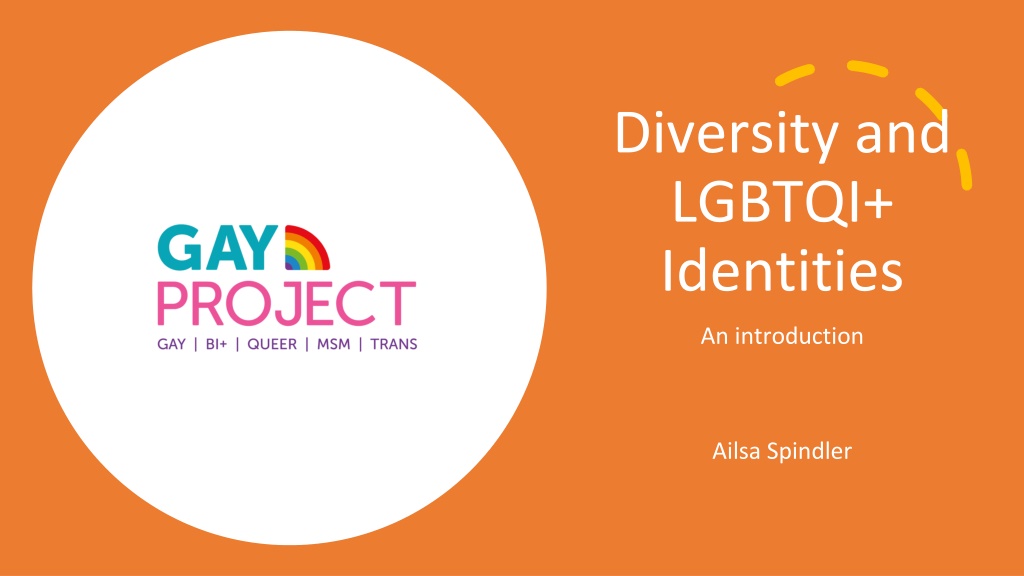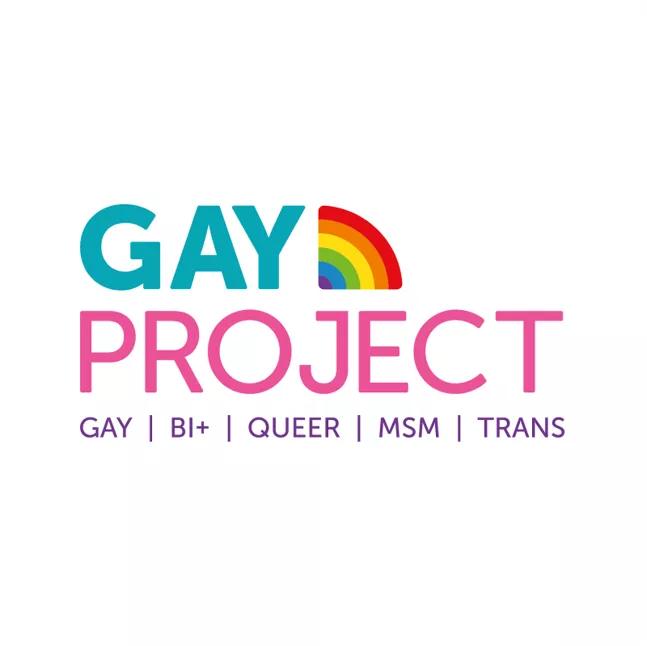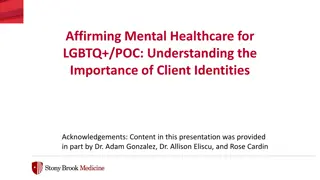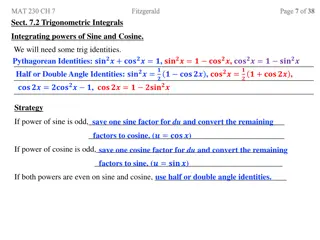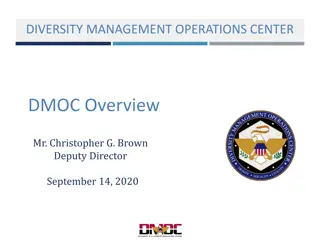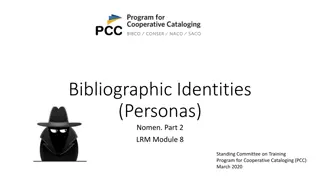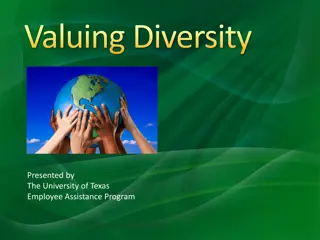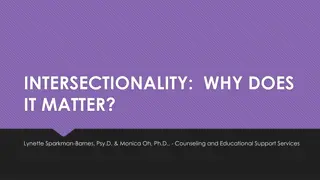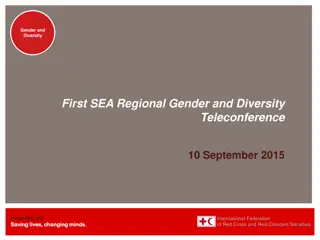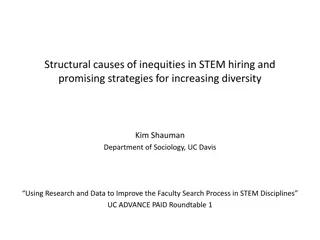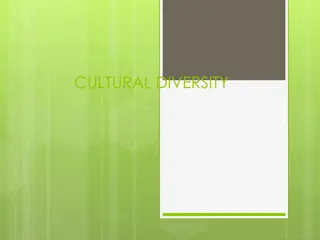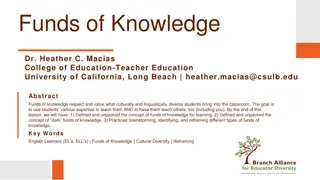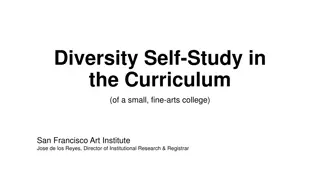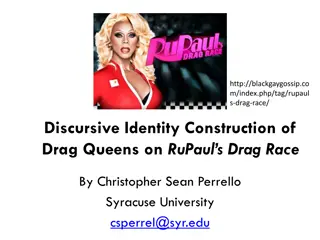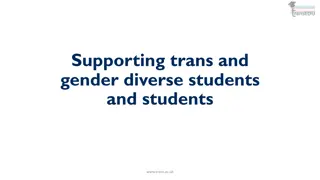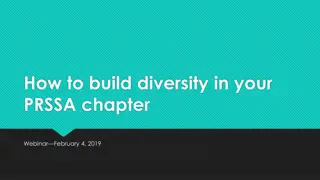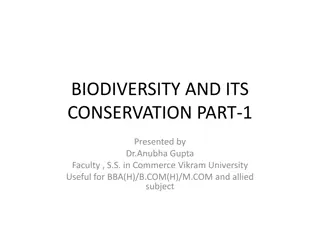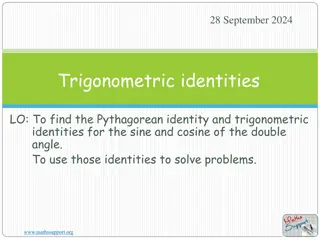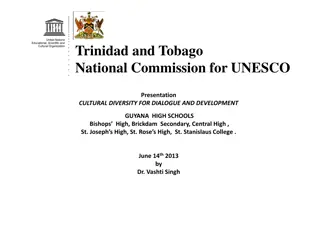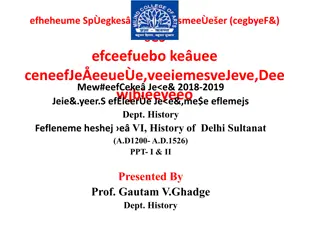Diversity and LGBTQI+ Identities
Diversity encompasses various dimensions like gender, age, sexual orientation, and disability among others. Inclusion is crucial to create a sense of belonging and to enable individuals to reach their full potential. Moving beyond Diversity and Inclusion, the concept of Belonging emphasizes psychological safety in the workplace. The importance of LGBTQI+ Inclusion, Diversity, and Belonging is highlighted through terminologies, spectrums, and sexual orientations. Recognizing identities on a spectrum allows for a deeper understanding and acceptance.
Download Presentation

Please find below an Image/Link to download the presentation.
The content on the website is provided AS IS for your information and personal use only. It may not be sold, licensed, or shared on other websites without obtaining consent from the author.If you encounter any issues during the download, it is possible that the publisher has removed the file from their server.
You are allowed to download the files provided on this website for personal or commercial use, subject to the condition that they are used lawfully. All files are the property of their respective owners.
The content on the website is provided AS IS for your information and personal use only. It may not be sold, licensed, or shared on other websites without obtaining consent from the author.
E N D
Presentation Transcript
Diversity and LGBTQI+ Identities An introduction Ailsa Spindler
Diversity is any dimension that can be used to differentiate groups or people from one another (e.g. gender, age, sexual orientation, family status, religion, ethnicity, and disability). Inclusion is a state of being valued, respected and supported. It generates a sense of belonging. Diversity, on its own, is not the answer. A culture of inclusion is essential to harness the power of individual diverse elements. It's vital to have an inclusive environment where everyone feels able to participate and achieve their full potential. WHAT IS DIVERSITY AND INCLUSION?
57% of organisations surveyed by LinkedIn for its Global Recruiting Trends 2018 said that they were moving beyond Diversity and Inclusion to Belonging. Here s why: diversity is being invited to the party, inclusion is being asked to dance, and belonging is dancing like no one s watching. BELONGING "Belonging is the feeling of psychological safety that allows employees to be their best selves at work. Even at the most diverse of companies, employees will disengage and leave if they don t feel included and accepted." - Linkedin
Introductions Terminology Spectrums Sexual Orientation Gender and Sex Gender Identity Gender Expression Minority Stress LGBT+ INCLUSION, DIVERSITY AND BELONGING
It is useful to think of sexual and gender identities in terms of a spectrum. A spectrum is used to classify something in terms of its position on a scale between two extreme points . SPECTRUMS Thus people can identify with a sexual or gender identity anywhere on a spectrum ranging from straight to gay OR man to woman and anywhere in between.
Sexual orientation is about who youre attracted to romantically or sexually and who you want to have relationships with. WHAT IS SEXUAL ORIENTATION? Sexual orientations include gay, lesbian, straight, bisexual, and asexual.
LESBIAN: A woman who is romantically or sexually attracted to other women. GAY: A man who is romantically or sexually attracted to other men. Most gay people don t like to be referred to as homosexual because of the negative historical associations with the word and because the word gay better reflects their identity. Terminology for Sexual Orientation ASEXUAL: Asexual people do not experience sexual attraction. However, many do experience romantic attraction and still take part in non-sexual intimate relationships. BISEXUAL: A person who is romantically, sexually and/or emotionally attracted to people of both sexes.
Pansexual: Sex therapist Dr. Kelly Wise defines pansexual as, someone who is attracted to people regardless of gender or biological sex. That is irrelevant. Pansexuality holds space for the idea that gender is very fluid. More Sexual Orientation stuff...... Heterosexual: Someone who is sexually or romantically attracted to the opposite sex.
MSM Men who have sex with men Other terms WSW - Women who have sex with women
SEX is biological and characterised by primary and secondary sex characteristics such as chromosomes, gonads, sex hormones or genitals. GENDER refers to the socially constructed characteristics of women and men such as norms, roles and relationships of and between groups of women and men. It varies from society to society and can be changed. GENDER AND SEX
GENDER refers to the socially constructed characteristics of women and men such as norms, roles and relationships of and between groups of women and men. It varies from society to society and can be changed. QUEER: A historically pejorative term that has been reclaimed by the communities* and used as a term of empowerment. It is an umbrella term that refers to anyone who identifies as anything other that heterosexual or cisgender. NON-BINARY/GENDER QUEER: This is an umbrella term to describe all gender identities that fall outside of the traditional binary of male and female. GENDER FLUID: Gender fluid individual experience different gender identities at different time. INTERSEX: Intersex refers to people born with sex characteristics that do not belong strictly to male or female categories. GENDER IDENTITY TERMINOLOGY
Gender Dysphoria: A medical term used to describe the uncomfortable feeling that a trans person's internal gender experience doesn t match their body. Transition: The process of changing genders. This can be social and / or medical. Medical transition may involve hormone replacement therapy and various surgeries. It is important to note that many trans people decide not to transition medically. Carrying out the medical process of transitioning is also not a pre-requisite to identifying as trans. FTM - female to male trans person - a transman MTF - male to female trans person a transwoman Other 'trans' terms
Pronouns are words used to refer to someone or something. Gender specific pronouns are he and she which are usually used for men and women respectively. Many non-binary people do not identify with these pronouns and choose to opt for more gender neutral pronouns like they or no pronouns at all. If unsure, it is okay to respectfully and discreetly ask someone which pronoun they prefer to use. Pronouns
Gender expression is how a person outwardly shows their gender identity. It includes physical expressions such as person s clothing, hairstyle, makeup, and social expressions such as name and pronoun choice. Some examples of gender expression are masculine, feminine, and androgynous. However, not everyone who expresses themselves in a way that varies from their assigned sex or gender identity is expressing their particular identity. For example, Drag Kings and Drag Queens are artists and performers who do not necessarily identify with the gender that they are expressing in performance. GENDER EXPRESSION
Heterosexual/straight: Sexual and romantic attraction to the opposite sex. Cisgender: Identifying with the gender one was assigned at birth. Heterosexual and cisgender
Please remember: Language is fluid and ever-evolving. There is no absolutely correct way to describe identities, although there are ways which are exclusionary and incorrect. A 'queer' person may use terms about themselves that would be offensive if used by others. If in doubt, check before you use an unfamiliar term. Lived experience is more valuable than any definition. A Note on Terminology
COMING OUT
Coming Out is the term used to describe "the process of realising one s LGBT identity and the decision to disclose this to others such as family, friends, classmates and colleagues" (LGBT Ireland). It is a misconception that coming out is a single event that happens once in an LGBT+ person s life. In fact, it is a lifelong process. However, the first time this event happens is usually very significant for the individual in question. Coming out
Coming out is probably one of the most extreme and difficult things you can do. Before you come out you have to deal with it all yourself and it took me six years to. And I couldn t be myself for those six years and it is, again, it s called in the closet because you are in the closet. No one can see you; they see this door because no one s ever opened up the closet to look inside (Gay, Male, 17)
Coming Out statistics 12 years: the most common age that an LGBT person discovers their sexual orientation or gender identity for themselves (average is 14) 17 years: the most common age to start coming out to others (average is 21) 5 to 7 years: number of years young LGBT people conceal their identity from others The period prior to coming out to others is often particularly stressful because of fear of rejection and isolation
BEING AN LGBT+ ALLY Don't assume Pronouns are personal Ask Be inclusive Listen questions Understand terms Know the law Know your privilege Challenge
